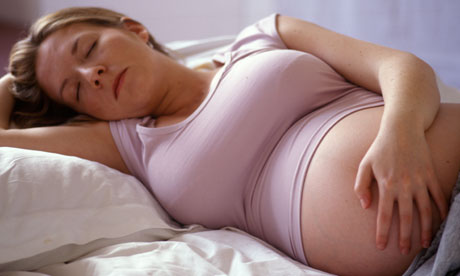
Mothers who sleep on their back or right-hand side on the night before giving birth are twice as likely to have a stillborn child compared with those who slept on their left, according to a study.
Researchers found that the risk of stillbirth for those sleeping on the left side was 1.96 per 1,000 births, and 3.93 per 1,000 births for any other position.
Tomasina Stacey, a midwifery lecturer at University of Auckland, who led the study, cautioned pregnant women not to be over-concerned by the finding. "It was an observational study, not one that can show cause and effect – all it does is show an association. It would be premature to jump up and down and say that everyone has got to sleep on their left. It's a starting point for future research."
In the UK, there were more than 4,000 stillbirths in 2009; almost a third of these occurred late in the pregnancy term, after 37 weeks.
"Stillbirth is a much bigger problem than most people realise, and many are unexplained," said Stacey. "In the UK and New Zealand, there has been very little change in the rate in the last 15 years."
For the study, published in the British Medical Journal, she and her colleagues spoke to 155 women who had stillborn babies in Auckland between 2006 and 2009. They were asked about, among other things, their positions on going to sleep and waking up in the final weeks and month before the death of their baby.
For the control group, the researchers randomly selected two women who were at the same number of weeks in their pregnancy and questioned them about their sleep in the days and month before the interview.
The researchers wanted to examine the effects of sleep disorders in pregnant women, such as sleep apnea or snoring, which could be a factor in stillbirths, because these conditions can reduce the amount of oxygen getting to the baby.
Instead, the study showed that sleep position on the night before birth was the decisive factor. Stacey said a possible explanation could be that when a woman does not sleep on her left side, the foetus could compress her inferior vena cava taking blood back to the heart, and a reduced flow means less oxygen gets to the mother's – and in turn the baby's – other organs.
"If you've got a strong healthy baby, then the slightly reduced blood flow is fine; but if you've got a baby that is compromised in some other way, then maybe that reduction in blood flow can be the tipping point," said Stacey.
The left lateral position is known in clinical settings to be the optimal position for looking after a woman in labour and is associated with foetal wellbeing in labour, she added.
An accompanying editorial in the journal by Lucy Chappell of King's College London says "any simple intervention that reduces the risk of stillbirth would be extremely welcome", but argues that the finding should be treated with caution. "A forceful campaign urging pregnant women to sleep on their left side is not yet warranted," she said, adding that the study needed to be replicated to be conclusive. Alexander Heazell, of the University of Manchester School of Medicine, also pointed to a weakness – the fact that mothers were asked to recall their sleep position 25 days after a stillbirth.
Stacey said her advice to those women who found it uncomfortable to sleep on their left was "not to worry about it too much". But, she added, at a population level, the associations between position and stillbirth might be important.
"We could make a difference to the stillbirth rate by encouraging people to sleep on their left."

